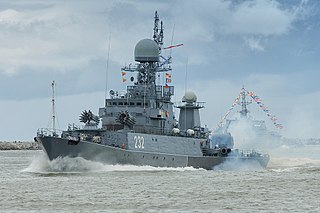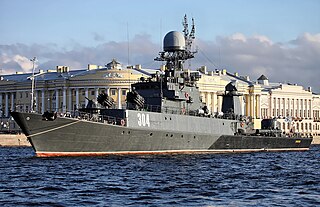
The Grisha class, Soviet designation Project 1124 Al'batros, are a series of anti-submarine corvettes built by the Soviet Union between 1970 and 1990 and later by Russia and Ukraine. These ships have a limited range and are largely used only in coastal waters. They have been equipped with a variety of ASW weapons and an SA-N-4 'Gecko' surface-to-air missile launcher. All were fitted with retractable fin stabilizers.

A submarine chaser or subchaser is a small naval vessel that is specifically intended for anti-submarine warfare. Many of the American submarine chasers used in World War I found their way to Allied nations by way of Lend-Lease in World War II.

The Poti class was the NATO reporting name for a group of anti-submarine warfare (ASW) corvettes built for the Soviet Navy. The Soviet designation was Project 204 small anti-submarine ships. These ships were the first Soviet warships powered by gas turbine engines; two propellers were mounted in tunnels to give a very shallow draught. A twin 57 mm (2 in) gun mounting provided self-defence. Three ships of the class were exported to Romania and six to Bulgaria during the Cold War. By 2008, all ships of the class were no longer extant.

JSC Zelenodolsk Shipyard is a shipbuilding company based in Zelenodolsk, Tatarstan, Russia. It is part of the Ak Bars Holding.

The RBU-1200 is a Russian anti submarine rocket launcher. The weapon system is remotely similar to the British Hedgehog anti submarine rocket launcher from the Second World War.

The Bashkortostan was a Parchim-class corvette in the Soviet Navy and later Russian Navy.

The Kalmykia is a Parchim-class corvette in the Soviet Navy and later Russian Navy.

The Kazanets is a Parchim-class corvette in the Soviet Navy and later Russian Navy.

The Zelenodolsk is a Parchim-class corvette in the Soviet Navy and later Russian Navy.

The Urengoy is a Parchim-class corvette in the Soviet Navy and later Russian Navy.

The Aleksin is a Parchim-class corvette in the Soviet Navy and later Russian Navy.

The Kabardino-Balkariya is a Parchim-class corvette in the Soviet Navy and later Russian Navy.
The MPK-105 was a Parchim-class corvette in the Soviet Navy and later Russian Navy.
The MPK-213 was a Parchim-class corvette in the Soviet Navy and later Russian Navy.
The MPK-219 was a Parchim-class corvette in the Soviet Navy and later Russian Navy.

Razyashchiy was a Project 1135 Burevestnik-class Large Anti-Submarine Ship or Krivak-class frigate of the Soviet Navy. Displacing 3,200 tonnes full load, the vessel was built around the Metel anti-submarine missile system. Launched on 22 July 1974, Razyashchiy joined the Pacific Fleet of the Soviet Navy. While serving in the Arabian Sea, in 1983, Razyashchiy suffered minor hull damage from colliding with the destroyer USS Fife while approaching a US fleet. The ship also undertook visits to Port Louis, Mauritius, and Danang, Vietnam, to, among other objectives, enhance the relationships between these countries and the Soviet Union. In 1991, the vessel was transferred to the newly-formed Russian Navy. After nearly twenty years of service, however, Razyashchiy was in a poor state and so was decommissioned on 29 October 1992 and sold to be broken up on 6 October 1994.

Sumy(U209) was a Grisha I-class anti-submarine corvette of the Ukrainian Navy. Prior to joining the Ukrainian Navy she was a former Soviet Navy corvette named MPK-43 and later Odesskiy Komsomolets.
Chernihiv(U205) was a Grisha II-class anti-submarine corvette of the Ukrainian Navy. Prior to joining the Ukrainian Navy she was a former Soviet Navy corvette named Izmail.














